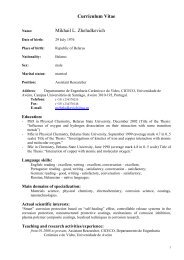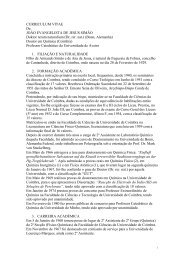XII Iberian Meeting of Electrochemistry XVI Meeting of the ...
XII Iberian Meeting of Electrochemistry XVI Meeting of the ...
XII Iberian Meeting of Electrochemistry XVI Meeting of the ...
You also want an ePaper? Increase the reach of your titles
YUMPU automatically turns print PDFs into web optimized ePapers that Google loves.
<strong>XII</strong> <strong>Iberian</strong> <strong>Meeting</strong> <strong>of</strong> <strong>Electrochemistry</strong> & <strong>XVI</strong> <strong>Meeting</strong> <strong>of</strong> <strong>the</strong> Portuguese Electrochemical Society O C 07<br />
Application <strong>of</strong> <strong>the</strong> Scanning Electrochemical Microscope to<br />
study <strong>the</strong> corrosion mechanism in thin organic coatings with<br />
defects<br />
Andreia Marques, Alda Simões<br />
ICEMS/ DEQB, Instituto Superior Técnico, Technical University <strong>of</strong> Lisbon - TULisbon, Portugal<br />
alda.simoes@ist.utl.pt<br />
Corrosion resistance <strong>of</strong> steel sheet is greatly increased when metallic and organic<br />
coatings are applied toge<strong>the</strong>r. In recent decades this concept was extended to coilcoating<br />
or pre-painted metal sheet, which is <strong>of</strong> special interest for <strong>the</strong> automotive<br />
industry. On <strong>the</strong> o<strong>the</strong>r hand, coil-coatings are difficult to weld, prone to cut-edge<br />
corrosion and <strong>the</strong> shaping process may introduce micro-defects. Hence, <strong>the</strong> development<br />
<strong>of</strong> coatings combining weldability and corrosion protection originated from self-healing<br />
<strong>of</strong> damaged areas is <strong>of</strong> special interest.<br />
Electrogalvanized steel sheet coil-coated with a 1.8µm weldable primer was choosen as<br />
an object <strong>of</strong> study. Electrical conductivity is assured by graphite particles dispersed in<br />
<strong>the</strong> polymeric matrix.<br />
To understand <strong>the</strong> corrosion mechanisms in thin conductive coatings and <strong>the</strong><br />
mechanistic <strong>of</strong> self-repair <strong>of</strong> induced micro-defects <strong>of</strong> different sizes, samples were<br />
tested in 0.05M NaCl solutions. The Scanning Electrochemical Microscope (SECM)<br />
was used to study <strong>the</strong> localized corrosion kinetics <strong>of</strong> <strong>the</strong> thin protective coating at <strong>the</strong><br />
defect area. These studies were compared to data obtained from electrochemical<br />
impedance spectroscopy.<br />
The SECM ultra microelectrode (UME) was used for amperometric measurements, at a<br />
constant cathodic potential <strong>of</strong> -0.70 V vs SCE. When <strong>the</strong> probe was located above <strong>the</strong><br />
defect, very low current densities were measured at <strong>the</strong> UME. At this potential, currents<br />
correspond essentially to O 2 reduction. These results reveal local depletion <strong>of</strong> oxygen in<br />
solution, thus corresponding to an active cathodic area. Thus, a map <strong>of</strong> surface reactivity<br />
was obtained with good spatial resolution.<br />
Impedance spectroscopy revealed <strong>the</strong> activity <strong>of</strong> <strong>the</strong> coating is low when compared to<br />
metal-rich primers, probably because its conductive particles are graphite instead <strong>of</strong><br />
metal particles. This explains why <strong>the</strong> impedance remains practically constant with time.<br />
Acknowledgments: The research was funded under contract RF CS-CT-2008-00028.<br />
September, 811, 2010. ISEL - Lisbon 46








